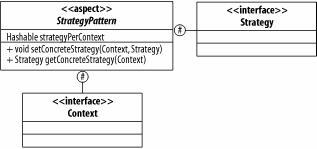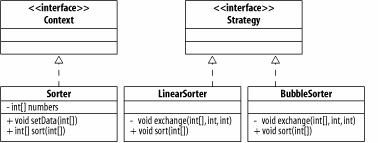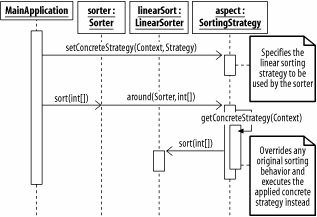Recipe19.7.Implementing the Strategy Pattern
Recipe 19.7. Implementing the Strategy PatternProblemYou want to apply the strategy pattern using AspectJ. SolutionThe strategy pattern provides a mechanism to separate client classes from the actual implementation details of a particular algorithm or strategy. Traditionally, all of the separate classes, which implement the strategy, implemented a distinct interface to allow the client to be decoupled from the different implementations. The abstract aspect in Example 19-13 uses the Director aspect-oriented design pattern (see Chapter 23) to provide a generic implementation of the strategy pattern that can be applied to your application. Example 19-13. Defining the strategy pattern using aspectspublic abstract aspect StrategyPattern { Hashtable strategyPerContext = new Hashtable( ); protected interface Strategy { } protected interface Context { } private Strategy Context.strategy = null; public void setConcreteStrategy(Context c, Strategy s) { strategyPerContext.put(c, s); } public Strategy getConcreteStrategy(Context c) { return (Strategy) strategyPerContext.get(c); } }DiscussionThe StrategyPattern abstract provides definitions of the Strategy and Context roles as interfaces. A hash table is used to look up the specific concrete strategy to be used. Figure 19-22 shows the structure of the StrategyPattern abstract aspect and the interfaces and behavior that it defines to support the strategy design pattern. Figure 19-22. The StrategyPattern aspect and the interfaces it defines for the design pattern's roles Example 19-14 shows how the abstract StrategyPattern aspect could be applied for a specific application. The SortingStrategy aspect defines the mapping of the strategy role to two types of sorter implementation and the overall context to be that of a Sorter class. The advice is applied to override the sort method on the Sorter context to apply the appropriate sorting strategy. Example 19-14. Applying the StrategyPattern aspect to an applicationpublic aspect SortingStrategy extends StrategyPattern { declare parents : Sorter implements Context; declare parents : LinearSorter implements Strategy; declare parents : BubbleSorter implements Strategy; int[] around(Sorter s, int[] numbers) : call(int[] Sorter.sort(int[])) && target(s) && args(numbers) { Strategy strategy = getConcreteStrategy(s); if (strategy instanceof BubbleSorter) ((BubbleSorter) strategy).sort(numbers); else if (strategy instanceof LinearSorter) ((LinearSorter) strategy).sort(numbers); return numbers; } }The SortingStrategy aspect declares two different sorting strategies for a particular context, which is sorting. The actual strategy that is to be executed depends on the type of strategy that has been declared at runtime for a particular context. Figure 19-23 shows the Sorter, LinearSorter, and BubbleSorter classes before the SortingStrategy aspect is applied. Figure 19-23. The Sorter, LinearSorter, and BubbleSorter classes Figure 19-24 shows the effects of applying the SortingStrategy aspect to the classes from Figure 19-23. Figure 19-24. The static structure after the strategy pattern has been applied to the Sorter, LinearSorter, and BubbleSorter classes Figure 19-25 shows an example interaction with the Sorter, LinearSorter, and BubbleSorter classes using the aspect introduced strategy pattern features. Figure 19-25. Using the new strategy pattern characteristics of the Sorter and LinearSorter classes See AlsoThe recipes in Chapter 16 contain more details on the mechanisms by which existing classes can be extended using aspects and the declare keyword; declaring and using abstract aspects are examined in Chapter 15; the args(Type or Identifier) pointcut is described in Recipe 11.3; the target(Type or Identifier) pointcut is examined in Recipe 11.2; the call(Signature) pointcut is covered in Recipe Recipe 4.1; exposing join point context is examined in Recipe 13.2; the Director aspect-oriented design pattern is explained in Recipe 23.3. |